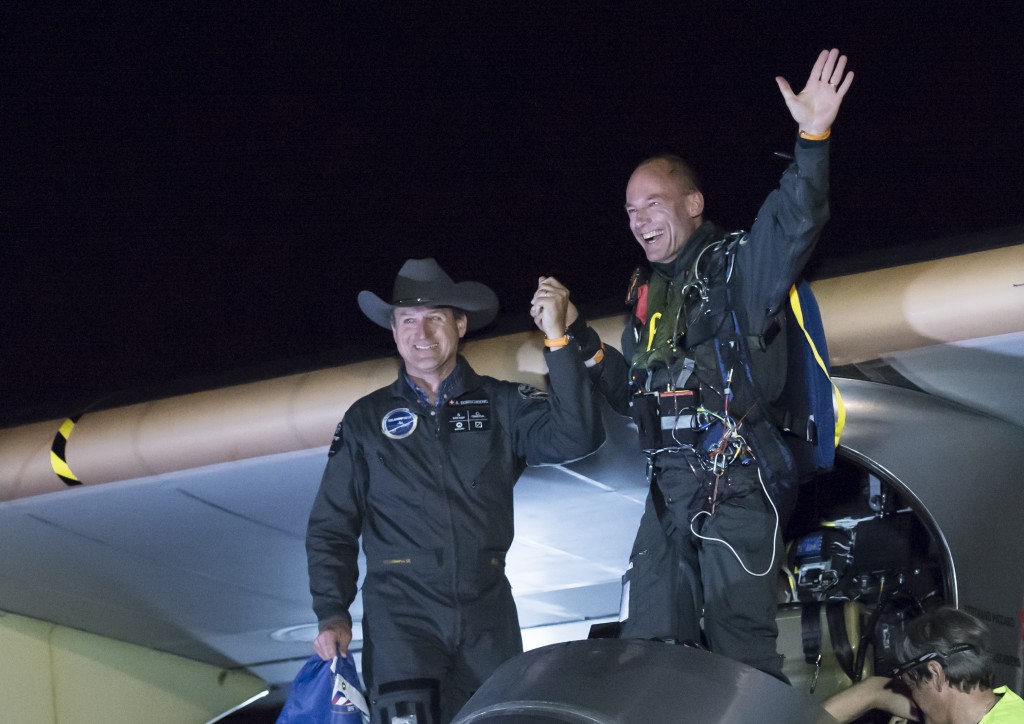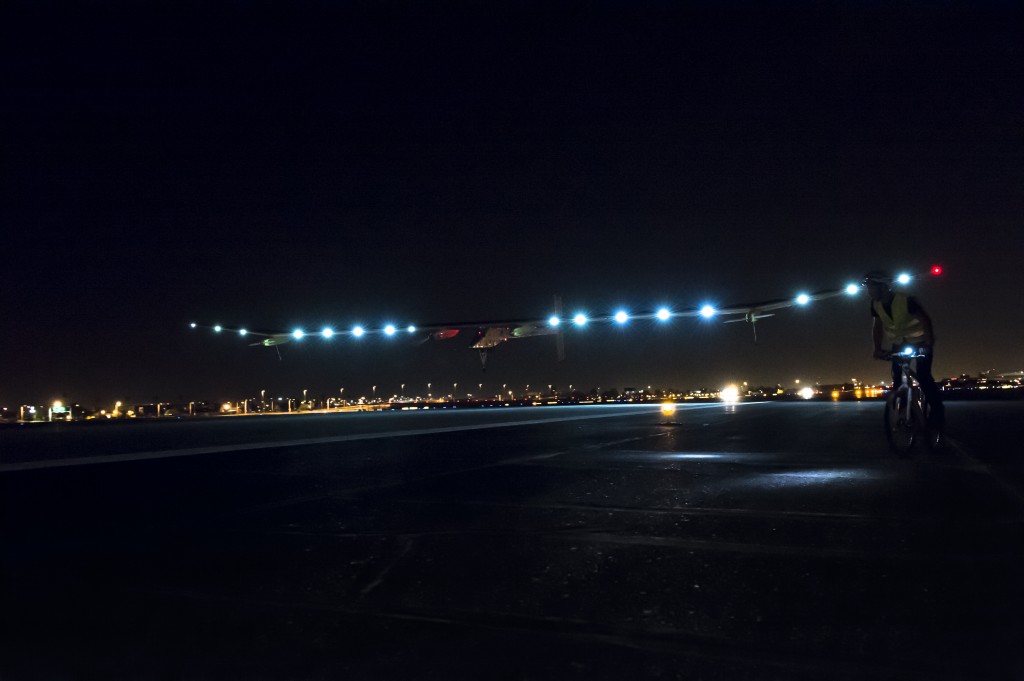Solar Plane visits Valley of the Sun during record-breaking tour
By Katie Peige
During the early hours of May 4, as many Star Wars fans were sending tweets, texts, and digital wishes of “May the Fourth be with you!” a small group of reporters gathered at Phoenix Sky Harbor International Airport with an array of tripods and long telephoto lenses to welcome a Swiss innovator to the Valley of the Sun.
It was dark. The lights of the runway twinkled in an almost melodic sequence beckoning the guest of honor. After much anticipation, a strange string of blue lights drifted in on the western horizon. The flying apparatus did not make a sound, and its eerie descent, with those blue lights spaced evenly across the 208-foot wingspan, would make any unaware bystander think this was indeed a close encounter of the third kind.
This was not a scene from a sci-fi flick but rather the product of a daring question: What would it take to develop a plane that could fly day and night without using one drop of fossil fuel?
That’s what a group of Swiss environmental engineers and aeronautical experts wanted to know when they took on the challenge to build the world’s first 24/7 solar plane.
The result of their $140 million, multi-year effort, sponsored by some of the world’s top corporate leaders in sustainability, is the Solar Impulse.
Solar Impulse, a feat in sustainable innovation and Swiss pioneering, is on a quest to spread the hope of renewable energy by completing a never-before-seen journey across the United States. This coast-to-coast renewable energy crusade aims to spark interest in and inspire innovation for a future that is not filled with doom and gloom of a climate crisis, but one that is sustainable through great feats of technology, collaboration, and the question, “Is it possible?”
Powered entirely by the sun’s energy thanks to the airplane’s 11,628 solar cells, the Solar Impulse defies the “impossible.” The solar cells are incredibly thin, measuring 135 microns, about the thickness of an average human hair, and are 22.7 percent efficient—cutting-edge in the solar industry compared to the efficiency of residential solar panels, which are about 16 percent efficient. The plane is light, weighing in at 3,527 pounds—the weight of a car.
 Meet the Innovators
Meet the Innovators
Solar Impulse is piloted by its founders Bertrand Piccard and André Borschberg. Each of these men has not only extensive and well-decorated aviation experience but also résumés that redefine the term over-achiever.
Piccard, for example, is not only a medical doctor, aeronaut, author, and lecturer, but also a goodwill ambassador to the United Nations and chairman of the humanitarian foundation Winds of Hope, which he co-founded. Piccard comes from a famous family of scientists and underwater and atmospheric explorers and has been flying since his teens. In 1999, Piccard established seven world records as he captained the Breitling Orbiter in the first non-stop around-the-world balloon flight.
Borschberg, CEO, co-founder, and pilot of Solar Impulse, is a graduate engineer in mechanics and thermodynamics, and holds a Master’s in Management Science from Massachusetts Institute of Technology (MIT). Borschberg also started flying in his youth and was trained as a fighter pilot in the Swiss Air Force. Over the years, Borschberg served as a business consultant, and as an investor and entrepreneur for various technological projects.
Together, Piccard and Borschberg make an incredible team. Piccard, the visionary, dreamed of flying a plane around the world with zero emissions and envisioned such a mission would uplift a spirit of pioneering for the renewable energy industry. To assist in turning the dream into reality, Borschberg brought his entrepreneurial skills to the project, assembled the technical team, and led the construction of the first prototype. The men will take turns piloting the Solar Impulse across America.
The Journey
Piccard was first in the cockpit as he took off from San Francisco and landed in Phoenix. The plane taxied to the welcoming committee with the use of a bicycle brigade. After all the hugs and photo opportunities, Piccard was finally hoisted from his perch, and was able to make his first steps on solid ground after a nearly day-long journey over the southwest. He greeted the press with his colleague, Borschberg, and proceeded to answer questions from the media.
When asked why Phoenix was chosen for the first stop, Piccard replied, “Because the enthusiasm of the people when we suggested different possibilities was overwhelming, and immediately we thought, ‘OK, the people here would like to see this airplane, so let’s start here.’”
“I think it’s the Valley of the Sun, no? That’s what you call it. It’s a good reason also to be here,” Borschberg added.
At one point, a fuel truck passed between the plane and the press audience, to which someone exclaimed, “We do not need any fuel, thank you!”
In fact, the airplane had plenty of power left even after landing. “I have three-fourths of the batteries left. We could plug in an electric car on the airplane and go back to the hotel…. It’s amazing technology,” Piccard said.
Both pilots are in excellent shape and have trained themselves to withstand extreme conditions and fatigue with various meditation and hypnotic techniques. Up in the air, there is a constant strain on the pilot’s endurance as they fly, without auto-pilot, for such prolonged periods of time, which leaves one to question how enjoyable the flight actually was.
“You know, I had my period of flying just for myself. Now if we fly, it’s because we really believe in something, we like to share it—we like to spread this vision about clean technologies for the future.”
 Since ultra-light weight is the goal for the airplane to be as efficient as possible, the flying accommodations are far from luxurious. Depending on the altitude, the pilot, who is alone and confined to the cockpit for each 20-hour leg of the journey, is either sweating or freezing. Food and water are precisely calculated based on need and weight.
Since ultra-light weight is the goal for the airplane to be as efficient as possible, the flying accommodations are far from luxurious. Depending on the altitude, the pilot, who is alone and confined to the cockpit for each 20-hour leg of the journey, is either sweating or freezing. Food and water are precisely calculated based on need and weight.
“It’s obvious it’s not the most comfortable way to travel, but we believe it’s the most powerful way to speak about new technologies and energy efficiency, because normally when we speak about the protection of the environment, when we speak about climate change—it’s really boring. It’s all the problems and nobody knows what to do. So we try to see it the other way around—what are the solutions that we can do that simultaneously protect the environment and also create jobs and sustain profit for the industry? So Solar Impulse, for this, is a good demonstration that renewable energies can achieve incredible and ‘impossible’ things.”
Two and a half weeks later, it was Borschberg’s turn to pilot the plane to Dallas, Texas and attempt to break his own world record—693 miles traveled by a solar airplane. On the morning of May 23, Borschberg landed successfully in Dallas, after his 830 mile flight from Phoenix, thus establishing a new world record for solar aviation.
They expect to reach their final destination of New York City sometime in July.
The team plans to complete another prototype by 2015 that will be able to fly around the world.
To learn more about the pilots, the engineering, and to track the Solar Impulse project as it continues its journey across America, visit solarimpulse.com
.
Top photo: Solar Impulse landing after midnight at Phoenix Sky Harbor International Airport. Photo by Fred Merz
Inset photo of pilots: André Borschberg and Bertrand Piccard just after the landing. Photo by Fred Merz
Inset photo of plane: Solar Impulse in Phoenix. Photo by Katie Peige







